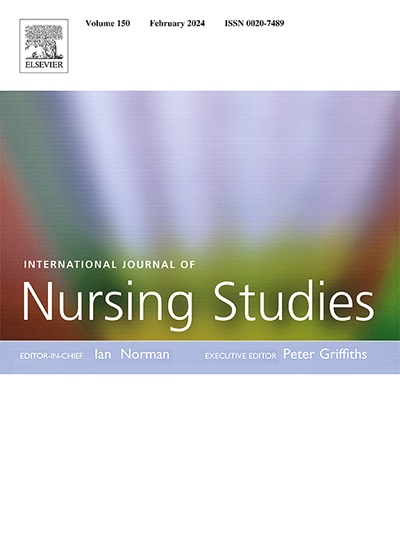使用游戏化干预来增强自闭症谱系障碍患者之间的社会互动和沟通:一项系统回顾和荟萃分析
IF 7.5
1区 医学
Q1 NURSING
引用次数: 0
摘要
传统的游戏化干预和严肃游戏已经被治疗自闭症谱系障碍的治疗师和研究人员广泛使用。最近的研究也表明了一种基于技术的游戏化趋势,用于训练自闭症患者的行为和社交技能。然而,这些游戏化干预在增强自闭症患者的社会互动和沟通结果方面的有效性尚不清楚。本研究对现有的针对自闭症谱系障碍患者的游戏化干预措施进行了系统回顾和荟萃分析,旨在概述常用的游戏化元素和特征,以增强他们的社交互动和沟通效果。方法系统检索自建库至2024年4月共11个文献数据库。实验研究,包括但不限于随机对照试验、准实验研究(如非随机研究、前后研究)和试点研究。医学主题标题术语、关键字和免费词,如“自闭症谱系障碍”、“游戏化”和“社会互动和交流”被用于搜索。将提取的数据进行叙事综合,并对研究结果进行荟萃分析。游戏化元素是基于最广泛采用的学习目的的游戏化元素进行分类的。结果20项研究共纳入349名受试者。在纳入描述性综合的297名参与者中,246名(82.8%)为男性,入组时平均年龄为11.55岁。患有自闭症谱系障碍的儿童和青少年是最常见的目标人群(k = 19.95%),其次是一般成年人(k = 1.5%)。与游戏化干预的应用相关的两个主要主题出现在纳入的研究中:干预参与的增强和预期干预结果的放大。常用的游戏化元素包括反馈(k = 10,50 %)、奖励(k = 10,50 %)、自定义学习(k = 9,45 %)、监控(k = 9,45 %)和个性化(k = 8,40 %)。其中四项研究在其干预措施中应用了5-7个要素。meta分析纳入了五项研究,显示游戏化干预对社会互动和沟通的总体积极影响(合并标准化平均差异:0.46;95% ci 0.08, 0.85;I2 0%)。结论本研究对目前用于自闭症谱系障碍患者社交互动和沟通技巧的游戏化元素和游戏化干预措施进行了全面综述。针对社会互动和沟通技巧的纳入研究的潜在益处突出了对这一群体进行进一步深入调查的必要性。建议未来进行更全面的随机对照试验和应用游戏相关设计的试验。本文章由计算机程序翻译,如有差异,请以英文原文为准。
The use of gamified interventions to enhance social interaction and communication among people with autism spectrum disorder: A systematic review and meta-analysis
Background
Traditional gamified interventions and serious games have been widely employed by therapists and researchers working with people with autism spectrum disorder. Recent studies have also indicated a trend towards technology-based gamification for training behavioral and social skills in autistic people. Nevertheless, the effectiveness of these gamified interventions in enhancing social interaction and communication outcomes among autistic people remains unclear.
Objective
This systematic review and meta-analysis of existing gamified interventions focused on people with autism spectrum disorder aimed to provide an overview of commonly used gamification elements and features for enhancing their social interaction and communication outcomes.
Methods
A total of 11 bibliographic databases were systematically searched from inception to April 2024. Experimental studies, including but not limited to randomized controlled trials, quasi-experimental studies (e.g., non-randomized studies, pre-post studies), and pilot studies. Medical Subject Heading terms, keywords, and free words such as ‘ASD’, ‘gamification’, and ‘social interaction and communication’ were used for the search. The extracted data were subjected to a narrative synthesis, and the study outcomes were subjected to a meta-analysis. Gamified elements were classified based on the most widely adopted gamification elements for learning purposes.
Results
Twenty studies involving 349 participants were eligible. Of 297 participants included for descriptive synthesis, 246 (82.8 %) were male, with a mean age at study entry of 11.55 years. Children and adolescents with autism spectrum disorder were the most common target populations (k = 19, 95 %), followed by the general adult population (k = 1, 5 %). Two main themes related to the application of gamification interventions emerged from the included studies: the augmentation of engagement in the intervention and the amplification of the desired interventional outcomes. Commonly used gamification elements included feedback (k = 10, 50 %), rewards (k = 10, 50 %), custom learning (k = 9, 45 %), monitoring (k = 9, 45 %), and personalization (k = 8, 40 %). Four of the included studies applied 5–7 elements in their interventions. Five studies were included in the meta-analysis, showing a positive overall effect of gamified interventions on social interaction and communication (pooled standardized mean difference: 0.46; 95 % CI 0.08, 0.85; I2 0%).
Conclusion
This study offers a comprehensive review of gamification elements and gamified interventions currently used in social interaction and communication skills among people with autism spectrum disorder. The potential benefits of included studies targeting social interaction and communication skills highlight the need for further in-depth investigation in this group. Future randomized controlled trials with more comprehensive development and trials that apply game-related design are suggested.
求助全文
通过发布文献求助,成功后即可免费获取论文全文。
去求助
来源期刊
CiteScore
15.00
自引率
2.50%
发文量
181
审稿时长
21 days
期刊介绍:
The International Journal of Nursing Studies (IJNS) is a highly respected journal that has been publishing original peer-reviewed articles since 1963. It provides a forum for original research and scholarship about health care delivery, organisation, management, workforce, policy, and research methods relevant to nursing, midwifery, and other health related professions. The journal aims to support evidence informed policy and practice by publishing research, systematic and other scholarly reviews, critical discussion, and commentary of the highest standard. The IJNS is indexed in major databases including PubMed, Medline, Thomson Reuters - Science Citation Index, Scopus, Thomson Reuters - Social Science Citation Index, CINAHL, and the BNI (British Nursing Index).

 求助内容:
求助内容: 应助结果提醒方式:
应助结果提醒方式:


